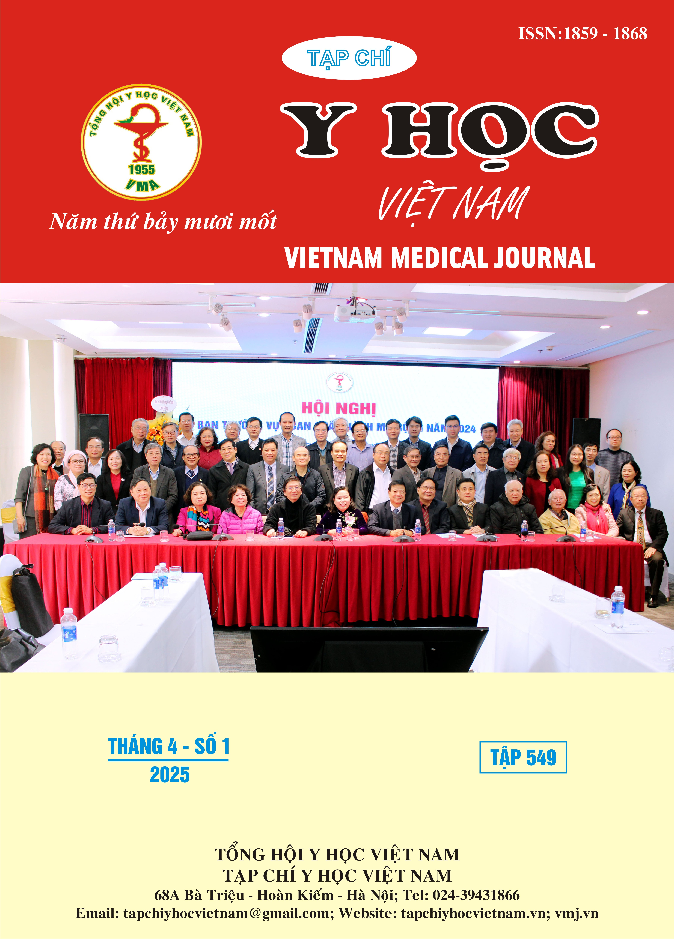ĐÁNH GIÁ KẾT QUẢ XA SAU ĐIỀU TRỊ THOÁI HÓA CỘT SỐNG THẮT LƯNG BẰNG ĐƯỜNG MỔ LỐI BÊN CÓ SỬ DỤNG CẢNH BÁO THẦN KINH
Nội dung chính của bài viết
Tóm tắt
Mục tiêu: Đánh giá kết quả lâm sàng và mức độ liền xương sau phẫu thuật điều trị hẹp ống sống và trượt đốt sống thắt lưng bằng đường mổ lối bên. Đối tượng và phương pháp nghiên cứu: 37 bệnh nhân hẹp ống sống thắt lưng và trượt đốt sống được phẫu thuật bằng phương pháp XLIF. Kết quả gồm thang điểm VAS lưng và chân, điểm ODI và điểm JOA. XQ hoặc CT đánh giá kết quả liền xương. Kết quả: 37 bệnh nhân với 40 tầng phẫu thuật. Có 16 nam và 21 nữ, độ tuổi trung bình là 58,11 ± 8,42. VAS lưng từ 7,19 ± 1,66 xuống 3,16 ± 1,72 sau mổ, 2,41±1,71 sau 1 tháng, 1,13±1,45 sau 6 tháng, VAS chân từ 6,84 ± 2,04 xuống 1,16 ± 1,76 sau mổ, 1,19±1,87 sau 1 tháng, 0,44±0,91 sau 6 tháng, Điểm ODI từ 26,62 ± 9,02 xuống 14,22 ± 8,8 sau 1 tháng, 8,75±9,88 sau 6 tháng điểm JOA từ 7,32 ± 2,85 lên 13,84 ± 2,07 sau 1 tháng, 15,47±1,57 sau 6 tháng. Sau 6 tháng liền xương mức độ 1 là 50%, liền xương mức độ 2 là 50%. Kết luận: XLIF là lựa chọn hiệu quả cho những bệnh nhân bị hẹp ống sống thắt lưng và trượt đốt sống. Hiệu quả liền xương tốt sau 6 tháng đánh giá.
Chi tiết bài viết
Từ khóa
lâm sàng, hình ảnh, hẹp ống sống thắt lưng, trượt đốt sống, phẫu thuật lối bên
Tài liệu tham khảo
2. Malham GM, Ellis NJ, Parker RM, et al. Maintenance of Segmental Lordosis and Disk Height in Stand-alone and Instrumented Extreme Lateral Interbody Fusion (XLIF). Clin Spine Surg. 2017;30(2): E90-E98. doi:10.1097/BSD. 0b013e3182aa4c94
3. Phillips FM, Isaacs RE, Rodgers WB, et al. Adult degenerative scoliosis treated with XLIF: clinical and radiographical results of a prospective multicenter study with 24-month follow-up. Spine (Phila Pa 1976). 2013;38(21):1853-1861. doi:10.1097/BRS.0b013e3182a43f0b
4. Rodgers WB, Gerber EJ, Patterson J. Intraoperative and early postoperative complications in extreme lateral interbody fusion: an analysis of 600 cases. Spine (Phila Pa 1976). 2011; 36(1): 26-32. doi:10.1097/BRS .0b013e3181e1040a
5. Hiyama A, Katoh H, Sakai D, Tanaka M, Sato M, Watanabe M. Short-term comparison of preoperative and postoperative pain after indirect decompression surgery and direct decompression surgery in patients with degenerative spondylolisthesis. Scientific Reports. 2020; 10(1):18887. doi:10.1038/s41598-020-76028-y
6. Elowitz EH, Yanni DS, Chwajol M, Starke RM, Perin NI. Evaluation of indirect decompression of the lumbar spinal canal following minimally invasive lateral transpsoas interbody fusion: radiographic and outcome analysis. Minimally invasive neurosurgery. 2011;54(5-6): 201-206. doi:https://doi.org/ 10.1055/s-0031-1286334
7. Rodgers WB, Lehmen JA, Gerber EJ, Rodgers JA. Grade 2 spondylolisthesis at L4-5 treated by XLIF: safety and midterm results in the “worst case scenario”. ScientificWorldJournal. 2012;2012:356712. doi:10.1100/2012/356712
8. Oliveira L, Marchi L, Coutinho E, Pimenta L. A radiographic assessment of the ability of the extreme lateral interbody fusion procedure to indirectly decompress the neural elements. Spine. 2010;35(26 Suppl): S331-S337. doi:https://doi. org/10.1097/BRS.0b013e3182022db0
9. Nourian AA, Harrington J, Pulido PA, McCauley JC, Bruffey JD, Eastlack RK. Fusion Rates of Lateral Lumbar Interbody Fusion Using Recombinant Human Bone Morphogenetic Protein-2. Global Spine J. 2019;9(4):398-402. doi:10.1177/2192568218797097
10. Zhang H, Dial B, Brown C. Early Fusion Rates After Direct Lateral Lumbar Interbody Fusion With Bone-Morphogenetic Protein. Int J Spine Surg. 2021;15(3):423-428. doi:10. 14444/8063


